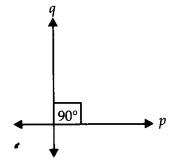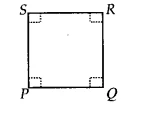NCERT Solutions for Class 9 Maths Exercise 5.1 Question 2

Understanding the Question 🧐
This question asks us to provide definitions for several fundamental geometric terms. An important part of the question is to identify other terms that need to be defined first, to make our primary definitions complete and logical. This exercise highlights how geometry is built upon a foundation of simple, well-understood concepts. These ncert solutions will guide you through each term with clarity.
Give a definition for each of the following terms. Are there other terms that need to be defined first? What are they, and how might you define them?
(i) Parallel lines 📝

Definition: Two or more lines in a plane are said to be parallel if they never intersect, no matter how far they are extended in either direction. The perpendicular distance between them is always constant.
Terms to be defined first:
- Point: A point is a location in space represented by a dot. It has no dimension (no length, width, or height).
- Line: A line is a straight collection of points extending infinitely in both directions. It has only one dimension: length.
- Plane: A plane is a flat, two-dimensional surface that extends infinitely.
- Intersect: When two or more lines cross each other, they are said to intersect.
Note: In Euclidean geometry, ‘point’, ‘line’, and ‘plane’ are technically undefined terms, treated as fundamental concepts.
(ii) Perpendicular lines 📝

Definition: Two lines in a plane are said to be perpendicular if they intersect each other at a right angle (an angle of &&90^\circ&&).
Terms to be defined first:
- Line and Plane (as defined above).
- Angle: An angle is formed when two rays (parts of lines) share a common endpoint (vertex). It measures the amount of turn between the two rays.
- Right Angle: An angle that measures exactly &&90^\circ&&.
(iii) Line segment 📝

Definition: A line segment is a part of a line that is bounded by two distinct endpoints. It has a definite, measurable length.
Terms to be defined first:
- Point and Line (as defined above).
- Endpoint: A point that marks the end of a line segment or ray.
(iv) Radius of a circle 📝

Definition: The radius of a circle is a line segment connecting the center of the circle to any single point on its boundary (circumference).
Terms to be defined first:
- Point (for the center).
- Circle: A circle is the set of all points in a plane that are at a fixed distance (the radius) from a fixed point (the center).
- Center: The fixed point inside a circle from which all points on the circumference are equidistant.
(v) Square 📝

Definition: A square is a quadrilateral in which all four sides are equal in length and all four interior angles are right angles (&&90^\circ&&).
Terms to be defined first:
- Point, Line Segment, Plane, and Angle (as defined above).
- Quadrilateral: A polygon with four sides and four vertices.
- Side: The line segments that form a polygon.
- Vertex: The point where two sides of a polygon meet.
Conclusion and Key Points ✅
This exercise teaches us that geometry is a hierarchical system. Complex shapes and concepts are defined using simpler, more fundamental ones. The terms ‘point’, ‘line’, and ‘plane’ are the basic building blocks that we accept as intuitively understood, even though they are formally undefined. Every other definition builds upon them.
- Geometry relies on a system of logical definitions.
- Complex terms like ‘square’ or ‘perpendicular lines’ depend on simpler terms like ‘line’, ‘point’, and ‘angle’.
- The terms point, line, and plane are the undefined pillars of Euclidean geometry.
- A line is infinite, while a line segment is finite and has a fixed length.
FAQ
Q: What are parallel lines?
A: Parallel lines are two or more lines on a plane that never intersect, no matter how far they are extended. The perpendicular distance between them is always constant.
Q: What is the difference between a line and a line segment?
A: A line extends indefinitely in both directions and has no endpoints. A line segment is a part of a line that is bounded by two distinct endpoints and has a fixed length.
Q: What terms need to be defined before defining ‘perpendicular lines’?
A: Before defining perpendicular lines, you first need to understand the terms ‘line’, ‘point’, ‘plane’, and ‘angle’. Perpendicular lines are two lines that intersect at a right angle (&&90^\circ&&).
Q: How is the radius of a circle defined?
A: The radius of a circle is the fixed distance from the center of the circle to any point on its boundary (circumference). It is a line segment connecting the center to the circumference.
Q: What are the essential properties of a square?
A: A square is a quadrilateral where all four sides are equal in length, and all four interior angles are right angles (&&90^\circ&&). To define it fully, one must first define ‘quadrilateral’, ‘side’, and ‘angle’.
Q: Are there any undefined terms in these definitions?
A: Yes, in Euclidean geometry, terms like ‘point’, ‘line’, and ‘plane’ are considered undefined. They are fundamental concepts that are explained through examples and axioms rather than formal definitions.
Further Reading
For more information on Euclid’s Geometry and to access the official Class 9 Maths textbook, you can visit the NCERT website: https://ncert.nic.in/. Mastering these definitions is key to building a strong foundation in geometry.


